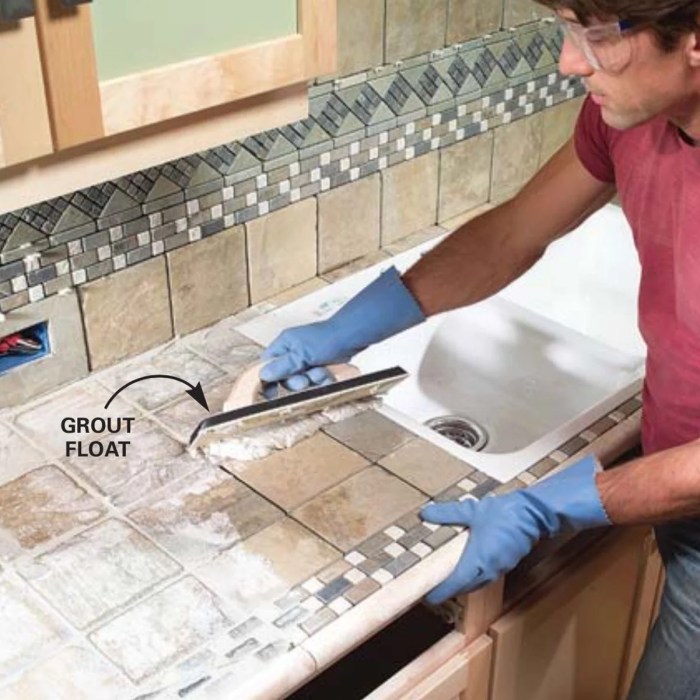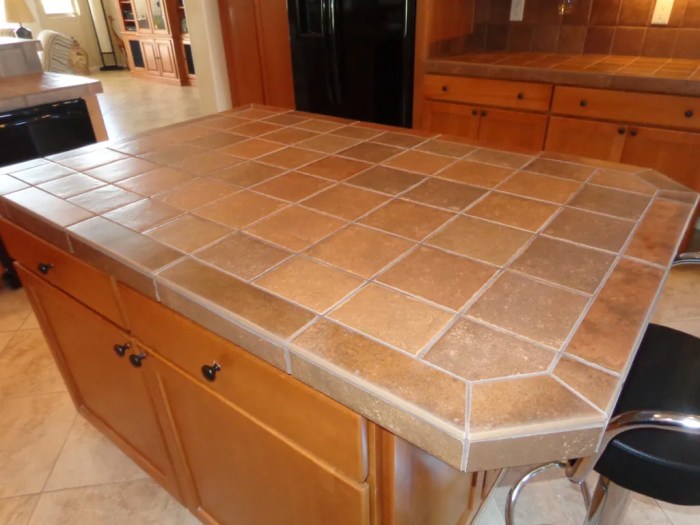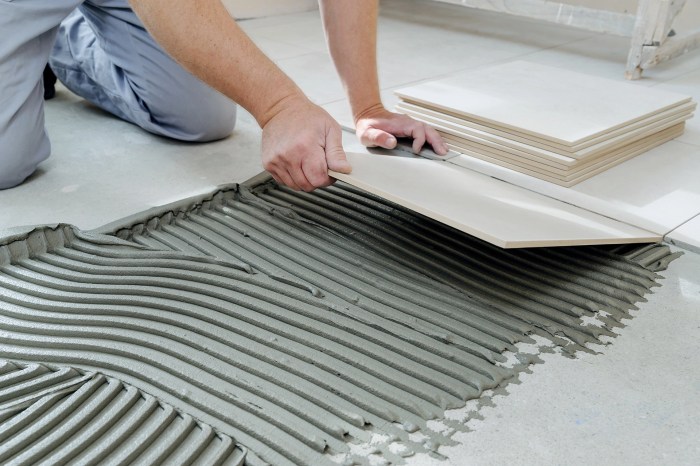Ron is tiling a countertop – Embark on a transformative journey with Ron as he tackles the art of countertop tiling. From meticulous planning to the final grouting and finishing touches, this comprehensive guide will empower you with the knowledge and techniques to create a stunning and durable countertop that will elevate your kitchen or bathroom space.
Follow Ron’s expert guidance as he shares his insights on selecting the ideal tiles, preparing the countertop, installing the tiles with precision, and grouting and finishing for a professional-grade result. Whether you’re a seasoned DIY enthusiast or a novice seeking to enhance your home, this guide will equip you with the confidence and skills to achieve a countertop that is both beautiful and functional.
Planning the Tiling Project
Tiling a countertop is a great way to update your kitchen or bathroom. But before you start, it’s important to plan your project carefully. This will help you avoid costly mistakes and ensure that your countertop looks its best.The first step in planning your tiling project is to measure your countertop.
This will help you determine how many tiles you need and how much grout you’ll need. Once you have your measurements, you can start shopping for tiles.When choosing tiles, it’s important to consider the style of your kitchen or bathroom, as well as the amount of traffic the countertop will get.
If you have a busy kitchen, you’ll want to choose tiles that are durable and easy to clean.Once you have your tiles, you’ll need to prepare your countertop for tiling. This involves cleaning the countertop and making sure it’s level.
You’ll also need to apply a thin layer of mortar to the countertop.The next step is to lay the tiles. Start by laying out the tiles in a dry run to make sure they fit properly. Once you’re satisfied with the layout, you can start setting the tiles in place.Once
the tiles are set, you’ll need to grout them. Grout is a thin paste that fills in the spaces between the tiles. It’s important to apply grout carefully to avoid getting it on the tiles.Once the grout has dried, you’ll need to seal the tiles.
Ron is busy tiling the countertop. It’s quite a challenge, but he’s getting there. Check out this image to see his progress. He’s doing a great job, and the countertop is starting to look really nice.
This will help protect them from stains and moisture.Tiling a countertop is a challenging project, but it’s also a rewarding one. By planning your project carefully and following the steps above, you can create a beautiful and durable countertop that will last for years to come.
Materials Needed
To tile a countertop, you will need the following materials:
- Tiles
- Grout
- Mortar
- Tile cutter
- Grout float
- Sealer
Tips for Tiling a Countertop
Here are a few tips for tiling a countertop:
- Start by laying out the tiles in a dry run to make sure they fit properly.
- Use a level to make sure the countertop is level before you start tiling.
- Apply a thin layer of mortar to the countertop before laying the tiles.
- Set the tiles in place and press them firmly into the mortar.
- Grout the tiles carefully to avoid getting it on the tiles.
- Seal the tiles once the grout has dried.
Selecting the Right Tiles
When choosing tiles for your countertop, there are several factors to consider:
First, determine the style you want for your kitchen. Do you prefer a classic look, a modern look, or something in between? Once you know the style you want, you can start narrowing down your choices.
Next, consider the durability of the tiles. If you have a busy kitchen, you’ll need tiles that can withstand heavy use. Porcelain and ceramic tiles are both durable and easy to clean, making them a good choice for countertops.
Finally, consider the cost of the tiles. Tiles can range in price from a few dollars per square foot to hundreds of dollars per square foot. Set a budget before you start shopping so you don’t overspend.
Types of Tiles
There are many different types of tiles available for countertops, including:
- Ceramic tilesare made from clay and fired at a high temperature. They are durable, easy to clean, and come in a wide variety of colors and styles.
- Porcelain tilesare similar to ceramic tiles, but they are made from a finer clay and fired at a higher temperature. This makes them even more durable and less porous than ceramic tiles.
- Granite tilesare made from natural stone. They are very durable and heat-resistant, but they can be expensive.
- Marble tilesare also made from natural stone. They are beautiful and elegant, but they are not as durable as granite tiles and they can be stained easily.
- Quartz tilesare made from a combination of natural stone and resin. They are durable, easy to clean, and come in a wide variety of colors and styles.
Each type of tile has its own advantages and disadvantages. The best way to choose the right tile for your countertop is to consider your needs and preferences.
Preparing the Countertop

Before you can begin tiling your countertop, you need to prepare the surface. This involves cleaning, leveling, and priming the countertop to ensure that the tiles will adhere properly and create a durable finish.
Cleaning the Countertop
The first step is to clean the countertop thoroughly. This will remove any dirt, grease, or other debris that could interfere with the adhesion of the tiles. Use a degreaser or a mixture of warm water and dish soap to clean the countertop.
Rinse the countertop thoroughly with clean water and allow it to dry completely before proceeding.
Leveling the Countertop
If the countertop is not level, the tiles will not be installed evenly. Use a level to check the countertop and identify any areas that need to be leveled. You can use a self-leveling compound to fill in any low spots or a sander to remove any high spots.
Once the countertop is level, allow the self-leveling compound to dry completely or the sanded area to settle before proceeding.
Priming the Countertop
Priming the countertop will help to create a bond between the tiles and the countertop. Apply a thin coat of primer to the countertop using a paintbrush or roller. Allow the primer to dry completely before proceeding.
Installing the Tiles

Installing tiles requires precision and attention to detail. Follow these steps for a successful installation:
1. Apply Tile Adhesive:
- Use a notched trowel to spread the adhesive evenly over the countertop.
- Choose a suitable adhesive for the type of tiles and countertop material.
- Apply a thin layer of adhesive, avoiding excess.
2. Lay the Tiles:
- Start from the center and work outwards, ensuring the tiles are aligned.
- Use tile spacers to maintain even spacing between the tiles.
- Press the tiles firmly into the adhesive, ensuring they are level.
3. Grout the Tiles:
- Mix the grout according to the manufacturer’s instructions.
- Apply the grout using a rubber float, filling the gaps between the tiles.
- Wipe off excess grout with a damp sponge.
Grouting and Finishing: Ron Is Tiling A Countertop

Grouting is the final step in tiling a countertop. It involves filling the spaces between the tiles with a cement-based material called grout. Grouting serves several important purposes:
- It locks the tiles in place, preventing them from moving or shifting.
- It fills any gaps or voids between the tiles, creating a smooth and even surface.
- It seals the tiles, protecting them from moisture and stains.
Mixing and Applying Grout
To mix grout, follow the manufacturer’s instructions. Typically, you will need to add water to the dry grout powder and mix until you achieve a thick, paste-like consistency. Once the grout is mixed, use a rubber float or grout bag to apply it to the joints between the tiles.
Press the grout firmly into the joints, making sure to fill them completely.
Types of Grout
There are several different types of grout available, each with its own advantages and disadvantages:
- Sanded groutcontains sand, which gives it a rougher texture. It is suitable for wider joints (1/8 inch or larger).
- Unsanded groutdoes not contain sand, which gives it a smoother texture. It is suitable for narrower joints (less than 1/8 inch).
- Epoxy groutis a two-part epoxy-based grout that is very strong and durable. It is resistant to stains and chemicals, making it ideal for areas that are subject to heavy use or moisture.
Sealing the Grout and Tiles
Once the grout has dried, it is important to seal it to protect it from moisture and stains. You can use a commercial grout sealer or a mixture of water and vinegar. Apply the sealer to the grout and tiles using a sponge or brush.
Allow the sealer to dry completely before using the countertop.
Maintenance and Care

Maintaining a tiled countertop is essential to preserve its beauty and functionality. Regular cleaning, sealing, and minor repairs will help extend its lifespan and keep it looking its best.
Cleaning, Ron is tiling a countertop
Regular cleaning removes dirt, grime, and spills that can accumulate on the countertop. Use a mild dish soap solution and a soft cloth to gently wipe down the surface. Avoid using abrasive cleaners or harsh chemicals, as they can damage the tiles or grout.
Sealing
Sealing the countertop helps protect it from stains and moisture penetration. Apply a penetrating sealer to the tiles and grout according to the manufacturer’s instructions. Reapply the sealer every few years or as needed to maintain protection.
Repairs
Minor damage to tiles or grout can be repaired using specialized products available at hardware stores. For cracked or chipped tiles, use a tile repair kit to fill in the damaged area. For loose or cracked grout, remove the old grout and replace it with a new grout mixture.
Detailed FAQs
What are the essential tools needed for countertop tiling?
A tile cutter, notched trowel, level, spacers, grout float, and sponge are essential tools for a successful tiling project.
How do I choose the right tiles for my countertop?
Consider factors such as durability, water resistance, style, and the overall design of your space when selecting tiles.
What is the best way to prepare the countertop before tiling?
Clean the surface thoroughly, level any uneven areas, and apply a primer to ensure proper adhesion.
How do I apply grout to the tiles?
Mix the grout according to the manufacturer’s instructions and apply it using a grout float, ensuring it fills all the gaps between the tiles.
How do I seal the grout and tiles?
Apply a grout sealer to protect the grout from stains and moisture, and seal the tiles to enhance their durability and shine.